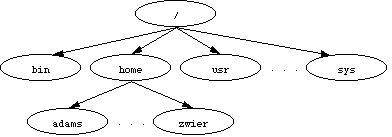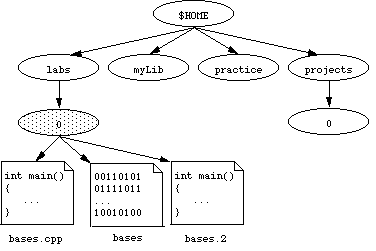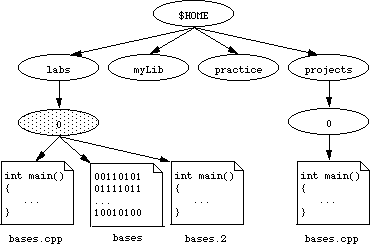
Your instructor will have to tell you how to access your account and how to start up the X Window System. There are too many variations to cover here. Eventually, you should be logged in and have a terminal window open to interact with.
The terminal window should have a blinking rectangle sitting to the right of a prompt that might look like this:
%or perhaps this:
<1>~:or something similar.
Question #0.UNIX.1: What does your prompt look like?
UNIX is prompting you to enter a command. Any time that you
see this prompt, you can enter in text as a command. Throughout this
manual, we will use % as our prompt.
Helpful hint: Never, ever type in the %. That's the prompt from UNIX; you must enter in the command after the prompt.
UNIX interaction consists of three steps:
The way in which you interact with a computer depends upon the computing environment of its operating system. For example, an environment that uses the three steps above for its interaction is called a command-line environment or a command-line interface.
The UNIX environment is case-sensitive, and virtually all UNIX commands use lower-case letters, so your caps-lock key should be off. This will cause you a great deal of frustration is you forget it, so keep this in mind.
Most UNIX systems these days provide you with the X Window System (also known as simply X or X11). X provides an environment in which you use the mouse to interact with on-screen windows, menus, and icons. Such environments are called graphical user interfaces (GUIs).
The terminal window that you pop up to interact with UNIX allows for a mixed environment of a command-line interface and a graphical-user interface.
In order to use a command-line environment, you must learn those commands that the environment understands. Let's first see what happens if you type something that the environment does not recognize.
Enter
% qwerty
For the sake of your own sanity, remember that % is the
system prompt, so you must not type it.
Question #0.UNIX.2: How does the system respond?
If you try other nonsense words, you'll find that the system responds in the same way.
Throughout this lab manual we'll be entering and running simple C++ programs. When we are done with a program, we'd like to be able to save it somewhere safe so that we don't have to type it in again. To save your program safely, the computer stores it on magnetic media (usually a hard disk) in a container called a file.
We'll create dozens of files, and so some means of organizing them is needed, otherwise they'll get mixed up with each other. Just as the documents in a filing cabinet are often kept in manila folders, we can create a container in which to keep related files, called a directory (or a folder).
Let's create a new directory. Enter this UNIX command:
% mkdir projectsOne last time: do not type in that
%. It's the UNIX
prompt which undoubtedly looks different in your environment.
After you type in the command, you should get the prompt back. If you get nothing else, then the command worked. If something when wrong, you'll get an error message.
The mkdir command is the UNIX command to make a directory. By placing the word projects
after the mkdir command, we tell the system that we want to
make a directory named projects.
Practice using the mkdir command, and make three directories:
one named practice, one named labs, and one named
myLib.
The mkdir gives no feedback unless something goes wrong. So
how do we know it did anything?
Enter
% lsThe
ls command stands for list the
contents of a directory. If all is well, you should see (at least)
the four directories you just created:
labs mylib practice projectsYou may see more than these four directories, depending on how things are set up at your institution. But if you don't see your four directories, then you probably didn't make the directories correctly. Go back and try that again, and then verify the new directories with
ls.
Many people like to visualize the relationships of these directories like this:

where $HOME represents our home directory, the directory where UNIX
places us at the beginning of a session.
The ls command can also be used to find out what is in a
particular directory.
Enter this command:
% ls labsIf you follow the
ls command with the name of a directory, it
displays that contents of that directory. Since each of your
directories are new (i.e., empty), there is nothing for ls to
display.
To get a more detailed listing of the current directory, enter
% ls -lThe
-l is called a switch
or flag that causes the ls
command to generate a long (i.e., detailed) listing. The hyphen
indicates to ls that the l has a special meaning;
it's not the name of a directory or file. Virtually all UNIX
commands have flags like this.
Detailed information about all of the switches that can be used with
a given UNIX command (such as ls) is available in the UNIX
on-line manual. The name of the command to search this manual is
man. For example, if you enter
% man lsthe manual entry for
ls will be displayed, providing
exhaustive information about that command, including all of its
switches, the meaning of the long listing information, and other
information.
You can use the spacebar to 'page forward' in the manual. Most
systems let you use b to 'page back'. The letter q
can be used to stop the man command; this may be necessary on
some systems even if you reach the end of the manual page.
Reading the UNIX manual pages is an acquired skill that requires much practice, and you will become more accomplished at it over time. Skim over a manual page to find just the information your currently interested in.
Question #0.UNIX.3: What does themanpage forlssay about the-lswitch?
Since we made practice just for practice, let's get rid of
it:
% rmdir practiceThe
rmdir command is the remove directory command, so this changes our picture as follows:

Whatever directory you specify following the rmdir command
will be removed from the current directory, provided that the
directory being removed is empty. To remove a non-empty directory
named DirectoryName, use this command:
% rm -r DirectoryName
This should only be used when DirectoryName contains
nothing important!
Using the ls command, verify that practice no longer
exists.
When you begin a computing session, UNIX always starts you out in your home directory, as mentioned above. You do not have to remain in your home directory; you can change to a different directory whenever you like.
The directory in which you are working at any particular time is
called your working directory. To find out the name of the working directory,
you can use the pwd command:
% pwd
Question #0.UNIX.4: What is printed by the pwd command for you?
UNIX systems utilize what is called a hierarchical directory system, meaning that directories can
contain other directories. There is one root directory denoted by / (a
single forward slash) which is the top directory; all
other directories are directly or indirectly in this root directory.
Run this command:
% ls /This lists the contents of the root directory. Within
/ are
a number of subdirectories, including usr, bin,
include, home, etc. Each of these contain other
directories and files. On many UNIX system, the home directories of
the users are stored within the home directory. Here
what this might look like on a particular machine:

A last word on the home directory: UNIX treats the tilde character
(~) as an abbreviation for your home directory, which can
save you a lot of typing if the path to your home directory has lots
of characters. We will use this abbreviation at the end of the lab.
If we created all of our files in our home directory, it would soon
become cluttered. By grouping related files within a directory, you
can organize your files. We created the labs directory to
store the files for the lab exercises; similarly, projects
can be used to store your programming projects files.
Since we are working on a lab exercise, let's change the working directory
to directory labs.
Enter this command:
% cd labsThe
cd command is the change directory
command that changes the working directory to the specified
directory. Similar to the mkdir command, cd will not
display anything if it works successfully (although you might notice
a change in your prompt). You will see an error message if something
fails.
Use the pwd command.
Question #0.UNIX.5: What does the pwd command display now?
Question #0.UNIX.6: How is the output of pwd different from before?
The effect of the cd command given above is to change the
preceding picture as follows:

Since pwd outputs the path (from the root) to the working
directory, the output of pwd changes each time you cd
to a different directory.
To see everything in a directory, enter this command:
% ls -aThe
-a switch tells ls to list all of the contents of
a directory.
You will notice two odd items in this output: a period . and
a double-period ... In the UNIX file system, . is
another name for the working directory (whatever directory you are
in); and .. is another name for the parent of the working
directory.
We created labs within our home directory. The cd labs command took us from that directory "down" into
labs. Once in that directory, . refers to that same
directory while .. refers to the directory it's in. So, to
go back "up" a directory, we can enter this command:
% cd ..Since
.. is always a synonym for the parent of the working
directory, regardless of its actual name, we can always use this
command wherever we are.
Remember, though, that it moves (or "changes") us up one directory,
relative to the current working directory. It does not always
return you to your home directory; you can get to your home directory
by entering cd alone without specifying a directory.
Use pwd to verify that you are currently in your home directory.
To wrap up this section, do the following:
labs.labs) named lab0.ls to verify that lab0 was created successfully.labs "down" into lab0.You should go back to the main exercise now. Return back here after you've copied, compiled, and executed your first program.
It is sometimes useful to be able to make a copy of a file, so that
we can modify a copy without modifying the original. To make a copy
of bases.cpp in a different file named bases2.cpp,
enter this command:
% cp bases.cpp bases2.cpp(You didn't forget the significance of the
%, did you?)
The cp command makes a copy of the file with the first name
(i.e., bases.cpp), and names the copy the second name (i.e.,
bases2.cpp).
Use the ls command to verify that the cp command
worked.
It's more often the case that we need to make a copy of a file in a
directory different from the one in which the file currently resides.
Both of the names bases.cpp and bases2.cpp are the
relative names of
these files. To use these names, we must be in the same directory as
they are.
However, every file or directory also has an absolute name, a name that starts with the
root directory (i.e., /), and lists each directory between
there and the file name---just as we saw in the output from pwd.
To use a file's (or directory's) absolute name, you need not be in the same directory as that file. For example, try entering:
% mkdir ~/projects/project0This uses the
mkdir command to make a new directory. Since
~ is another name for our home directory, we just made a new
directory inside projects (which we created earlier), called
project0, using an absolute path name. Here is the picture:

Almost all of the UNIX file manipulation commands accept either relative or absolute file names. For example, you don't need to be in a directory to see its contents. Enter this command:
% ls ~/projectsYou should see the directory you just made.
Similarly, to put a copy of bases.cpp in that new directory,
you can enter this command:
% cp bases.cpp ~/projects/project0A copy of
bases.cpp will be stored in that directory.

The cp command thus behaves differently, depending on whether
you specify a file or a directory as the second name: if you specify
a file as the second name, then the cp command will store the
copy in a file with that name. If you specify a directory as the
second name, then cp will place a copy in that directory with
the name as the original.
Using ls and an absolute path name, verify that there is a
copy of bases.cpp in ~/projects/project0.
Question #0.UNIX.7: What is your ls command?
Sometimes we decide after the fact that a file would be better off
with a different name. To change the name of bases2.cpp to
bases.bak, enter this command:
% mv bases2.cpp bases.bakThe
mv command moves the first file to
the second file, effectively renaming it. It can be used with both
relative and absolute file names, and can be used to rename
directories.
In addition to a printout of your program, many labs will ask you for
a sample
execution. Use the script command. After you enter this
command, everything you type and everything any program
prints is recorded in a file named typescript.
Here's how you should use it:
% script % Run your program as many times as needed. ... % exitIt's important that you type
exit at the end so that the file
named typescript is closed up properly.
You can print the typescript file just as you would any text
document.
The various files you have created take up valuable disk space, and
so we will remove all of the files from lab0 except for our
source program bases.cpp (the others can always be easily
re-generated from this source program). To remove bases.bak,
enter this command:
% rm bases.bakThe
rm command removes whatever file you
specify. Earlier we saw that when rm is invoked with the
-r switch, it recursively removes a directory and everything
within it.
Use the rm command to remove the typescript, bases.cpp~ (a back-up file created by emacs), and bases
files. Note that some environments may be configured to display
* and / symbols after executables and directories
(respectively). Do not type in these characters, especially the *, as part of the file name. Very, very,
very bad things will happen if you ignore this advice.
Use the ls command to verify that all of the files except
bases.cpp are gone. If there are other files remaining in
your lab0 directory, use the rm command to remove
them, as well.
Then end your session with the computer, following your instructor's instructions.
If your head feels ready to explode, don't panic! This first lab covers a great deal of material, that you will use over and over again, and as you do so, you will begin to naturally memorize those commands that you use most frequently. You can speed up the process by reviewing the steps we went through in this exercise.
You will only learn this material by doing it many, many times and if you have this reference handy. Be very, very thankful that you've already bookmarked this page---right?!
Here's a quick reference pages of UNIX commands.